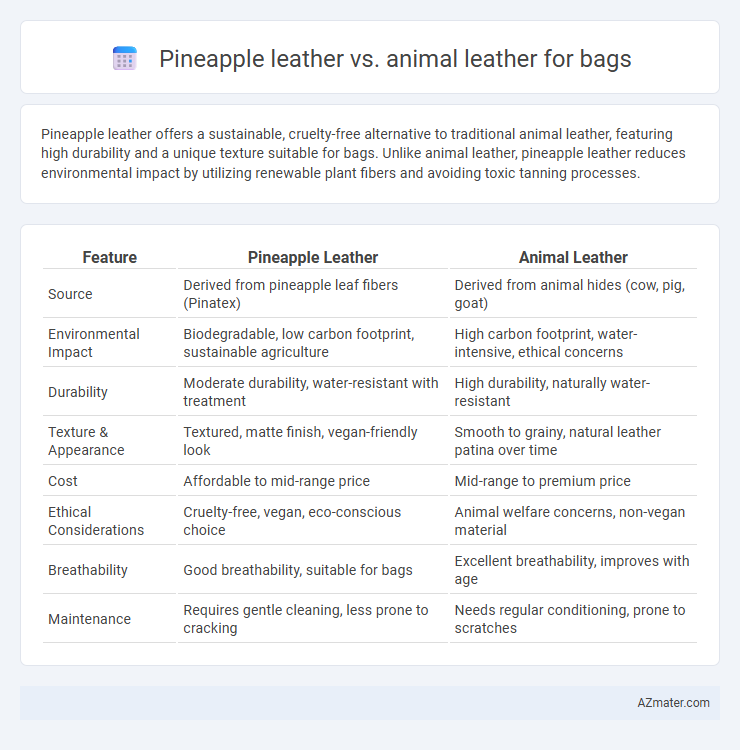Pineapple leather offers a sustainable, cruelty-free alternative to traditional animal leather, featuring high durability and a unique texture suitable for bags. Unlike animal leather, pineapple leather reduces environmental impact by utilizing renewable plant fibers and avoiding toxic tanning processes.
Table of Comparison
| Feature | Pineapple Leather | Animal Leather |
|---|---|---|
| Source | Derived from pineapple leaf fibers (Pinatex) | Derived from animal hides (cow, pig, goat) |
| Environmental Impact | Biodegradable, low carbon footprint, sustainable agriculture | High carbon footprint, water-intensive, ethical concerns |
| Durability | Moderate durability, water-resistant with treatment | High durability, naturally water-resistant |
| Texture & Appearance | Textured, matte finish, vegan-friendly look | Smooth to grainy, natural leather patina over time |
| Cost | Affordable to mid-range price | Mid-range to premium price |
| Ethical Considerations | Cruelty-free, vegan, eco-conscious choice | Animal welfare concerns, non-vegan material |
| Breathability | Good breathability, suitable for bags | Excellent breathability, improves with age |
| Maintenance | Requires gentle cleaning, less prone to cracking | Needs regular conditioning, prone to scratches |
Introduction to Pineapple Leather and Animal Leather
Pineapple leather, also known as Pinatex, is an innovative sustainable material made from pineapple leaf fibers, offering an eco-friendly alternative to traditional leather. Animal leather, derived from the tanned hides of cattle or other animals, is renowned for its durability, texture, and luxurious feel in bag manufacturing. The comparison highlights pineapple leather's biodegradable and cruelty-free benefits versus animal leather's established strength and natural breathability.
Material Origins and Manufacturing Process
Pineapple leather, derived from the fibrous leaves of the pineapple plant, undergoes a sustainable manufacturing process involving drying, pressing, and blending with eco-friendly binders to create a durable, vegan alternative to animal leather. Animal leather originates from the hides of cattle, processed through tanning methods that use chemicals like chromium or vegetable tannins to enhance durability and flexibility. The eco-impact of pineapple leather is significantly lower due to its plant-based origin and minimal chemical use compared to the resource-intensive and pollutive processes in animal leather production.
Environmental Impact Comparison
Pineapple leather, derived from sustainable pineapple leaf fibers, offers a significantly lower environmental footprint compared to traditional animal leather, as it requires no animal farming, reducing methane emissions and deforestation. Its production uses less water and eliminates toxic chemicals commonly involved in tannery processes, minimizing soil and water pollution. Animal leather's impact includes high greenhouse gas emissions, extensive land use, and substantial energy consumption, making pineapple leather a more eco-friendly choice for bags.
Durability and Longevity
Pineapple leather, crafted from fibers derived from pineapple leaves, offers a sustainable alternative to traditional animal leather but generally exhibits lower durability and longevity. Animal leather, especially full-grain varieties, provides superior resistance to wear and tear due to its dense fibrous structure, extending the lifespan of bags significantly. While pineapple leather is water-resistant and lightweight, it may degrade faster under heavy use compared to the robust and long-lasting nature of genuine animal leather.
Aesthetic Qualities and Design Flexibility
Pineapple leather offers a unique texture and vibrant color range that enhances visual appeal and allows for innovative design patterns not achievable with traditional animal leather. Unlike the consistent grain and classic finish of animal leather, pineapple leather's natural fibers create distinctive, eco-friendly aesthetics suited for modern, trend-forward bags. The material's pliability supports intricate shapes and embossing techniques, expanding creative possibilities for designers seeking sustainable alternatives without sacrificing style.
Comfort and Weight Differences
Pineapple leather, made from natural pineapple leaf fibers, offers a lightweight alternative compared to traditional animal leather, significantly reducing the overall weight of bags for enhanced comfort during extended use. Its breathable texture allows better air circulation, preventing moisture buildup and increasing comfort, unlike denser animal leather which can feel heavier and less flexible. The sustainable nature of pineapple leather also appeals to eco-conscious consumers seeking cruelty-free alternatives without sacrificing practicality in everyday carry items.
Cost and Market Availability
Pineapple leather, made from sustainable Pinatex material, generally costs less to produce due to lower resource requirements and eco-friendly processing, making it an affordable alternative to traditional animal leather. Animal leather carries higher production costs linked to livestock farming, tanning, and environmental regulations, contributing to its premium price on the market. Market availability of pineapple leather is increasing as demand for vegan and sustainable bags grows, while animal leather remains widely accessible but faces shifting consumer preferences toward cruelty-free options.
Ethical Considerations and Animal Rights
Pineapple leather, made from sustainable pineapple leaf fibers, offers a cruelty-free alternative to traditional animal leather, aligning with ethical considerations and promoting animal rights by eliminating the need for animal farming and slaughter. Unlike animal leather, which involves raising animals often in intensive farming conditions with significant animal welfare concerns, pineapple leather supports reduced environmental impact and respects wildlife. Choosing pineapple leather bags reflects a commitment to compassionate fashion while addressing ethical and ecological issues linked to animal leather production.
Consumer Trends and Brand Adoption
Pineapple leather, crafted from sustainable Pinatex fibers, is gaining traction among eco-conscious consumers seeking cruelty-free alternatives to traditional animal leather bags. Leading fashion brands like Gucci and Patagonia are adopting pineapple leather to meet rising demand for ethical and environmentally friendly products. This shift reflects a broader consumer trend favoring plant-based materials, driving innovation in handbag design and material sourcing.
Final Verdict: Which Leather is Best for Bags?
Pineapple leather, made from sustainable Pinatex fibers, offers a cruelty-free, eco-friendly alternative to traditional animal leather, with durability and water resistance suitable for everyday bag use. Animal leather remains prized for its natural strength, aging quality, and luxurious texture, but involves ethical concerns and higher environmental impact. For consumers prioritizing sustainability and innovation, pineapple leather is an excellent choice, while animal leather appeals to those seeking classic durability and timeless style.

Infographic: Pineapple leather vs Animal leather for Bag
 azmater.com
azmater.com